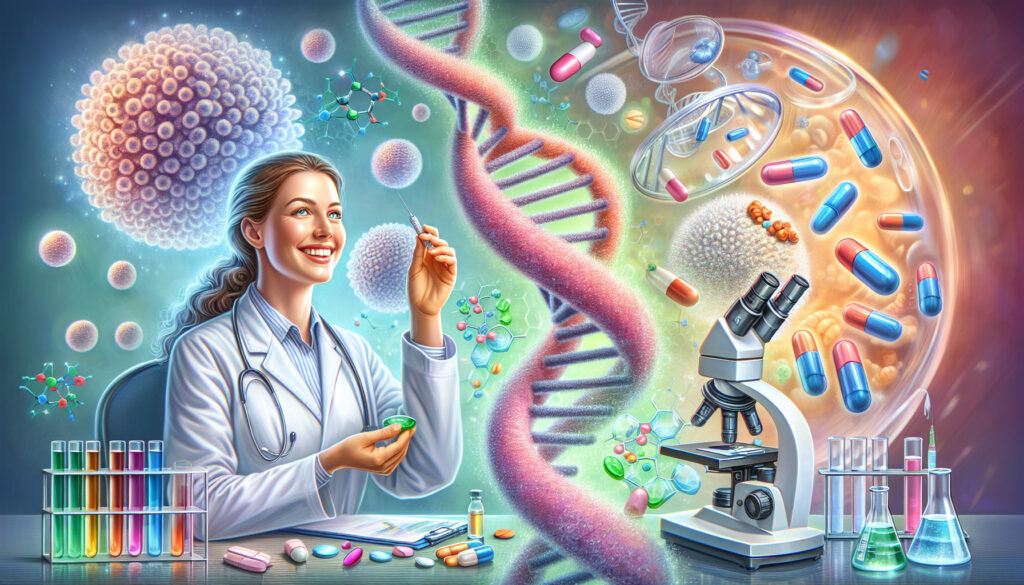
In a world where antibiotics are losing their edge, a new hero emerges from the lab: vaccine. As we face the looming threat of antimicrobial resistance (AMR), scientists are turning to an unexpected ally in the fight against superbugs. 🦠💉
Imagine a future where bacterial infections are no longer a death sentence, where hospitals save billions in treatment costs, and where we can reduce antibiotic use by millions of doses. This isn’t science fiction—it’s the potential reality offered by innovative vaccine technologies. From mRNA breakthroughs targeting C. difficile to phage therapies combating foodborne illnesses, the medical community is on the brink of a revolution in how we approach disease prevention and treatment.
As we delve into the world of these powerful vaccines, we’ll explore the growing threat of AMR, the promising developments in vaccine research, and the challenges that lie ahead. Join us on a journey through the frontlines of medical innovation, where the battle against antibiotic resistance is being fought with ingenuity and hope. 🌟🔬
The Growing Threat of Antimicrobial Resistance

A. Understanding AMR and its global impact
Antimicrobial resistance (AMR) has emerged as a critical global public health threat, with far-reaching consequences for human health and the global economy. In 2019, AMR was responsible for an estimated 1.27 million deaths directly, while contributing to 4.95 million deaths overall. This staggering toll underscores the urgent need to address this growing crisis.
The impact of AMR is not uniformly distributed across the globe. Low- and middle-income countries are disproportionately affected, facing greater challenges in healthcare access and infrastructure. This disparity highlights the need for a coordinated global response to combat AMR effectively.
AMR’s economic burden is equally alarming:
| Economic Impact | Projected Cost by 2030 |
|---|---|
| Healthcare costs | Additional $1 trillion |
| GDP losses | Up to $3.4 trillion |
These figures illustrate the potential for AMR to destabilize healthcare systems and economies worldwide if left unchecked.
B. Limitations of traditional antibiotics
The rise of AMR has exposed significant limitations in our current arsenal of antibiotics. Several factors contribute to this growing challenge:
- Overuse and misuse of antimicrobials in human, animal, and plant domains
- Evolution of pathogens to evade existing medicines
- Lack of innovation in antibiotic development
The 2022 GLASS report revealed concerning resistance rates, with 42% of E. coli strains showing resistance to third-generation cephalosporins. This trend extends beyond bacteria, affecting fungi and crucial infections like HIV, tuberculosis, and malaria.
The clinical pipeline for new antibiotics is alarmingly depleted:
- Only 27 antibiotics currently in development
- Of these, a mere 6 are considered innovative
This shortage of novel antimicrobials leaves healthcare providers with limited options to combat increasingly resistant pathogens.
C. The need for innovative solutions
Addressing the AMR crisis requires a multifaceted approach that goes beyond traditional antibiotic development. Key strategies include:
- Implementing a One Health approach, integrating efforts across human health, animal health, and environmental sectors
- Developing national action plans aligned with the Global Action Plan on AMR
- Enhancing surveillance through systems like the Global Antimicrobial Resistance and Use Surveillance System (GLASS)
- Promoting antimicrobial stewardship through initiatives like the AWaRe classification system
- Investing in research and development of alternative therapies, such as bacteriophages and antivirulence drugs
The WHO has established priority pathogen lists to guide research efforts and stimulate innovation in AMR-related research. This initiative aims to focus resources on the most pressing threats and encourage the development of novel antimicrobial agents.
With this comprehensive understanding of the AMR challenge and the limitations of current approaches, we can now explore one of the most promising avenues for combating this global threat. In the next section, “Vaccines: A Powerful Weapon Against AMR,” we’ll delve into how immunization strategies can play a crucial role in preventing infections and reducing the need for antibiotics, thereby addressing the root causes of antimicrobial resistance.
Vaccines: A Powerful Weapon Against AMR

Now that we have explored the growing threat of antimicrobial resistance, let’s delve into how vaccines serve as a powerful weapon against AMR. Vaccines offer a proactive approach to combat this global health crisis by reducing our reliance on antibiotics and mitigating the spread of drug-resistant pathogens.
A. How vaccines reduce reliance on antibiotics
Vaccines play a crucial role in reducing our dependence on antibiotics by preventing infections before they occur. By stimulating the immune system to recognize and fight specific pathogens, vaccines effectively decrease the incidence of bacterial infections. This preventive approach significantly reduces the need for antibiotic treatments, thereby lowering the risk of developing and spreading antimicrobial resistance.
Consider the following ways vaccines contribute to reducing antibiotic use:
- Proactive prevention of bacterial infections
- Decreased transmission of pathogens within communities
- Enhanced immune response against targeted bacteria
- Reduced risk of secondary infections that often require antibiotic treatment
B. Potential impact on antibiotic use reduction
The implementation of effective vaccination programs has the potential to substantially reduce antibiotic consumption on a global scale. According to the World Health Organization (WHO), proper utilization of existing vaccines could prevent up to 106,000 deaths annually and significantly decrease antibiotic usage.
To illustrate the potential impact of vaccines on antibiotic use reduction, let’s examine a comparative table:
| Pathogen | Current Antibiotic Use | Estimated Reduction with Vaccine Implementation |
|---|---|---|
| Group A Streptococcus | High | Significant (No vaccine currently available) |
| Tuberculosis (MDR-TB) | 480,000 cases (2015) | Substantial reduction possible |
| Staphylococcus aureus | High | Moderate to high (New vaccines needed) |
| Klebsiella pneumoniae | Increasing | Potential for significant reduction |
| Clostridium difficile | High | Moderate to high (New vaccines in development) |
It’s important to note that while existing vaccines are crucial in the fight against AMR, they alone are insufficient to tackle the entire problem. The development of new vaccines targeting antibiotic-resistant pathogens is essential to address the full spectrum of AMR challenges.
C. Economic benefits of vaccine implementation
Implementing comprehensive vaccination programs not only improves public health but also offers substantial economic benefits. By reducing the incidence of infections and the subsequent need for antibiotic treatments, vaccines can lead to significant cost savings in healthcare systems worldwide.
The economic advantages of vaccine implementation include:
- Reduced healthcare costs associated with treating antibiotic-resistant infections
- Decreased burden on healthcare facilities and resources
- Improved productivity due to fewer sick days and hospitalizations
- Lower expenses related to antibiotic development and production
- Potential savings in billions of dollars across global healthcare systems
The WHO estimates that effective utilization of current vaccines could save billions in healthcare costs. This economic impact underscores the importance of prioritizing vaccine development and implementation as a key strategy in combating AMR.
As we move forward in our discussion, it’s crucial to recognize that while vaccines offer immense potential in the fight against AMR, they are just one part of a comprehensive solution. In the next section, we’ll explore promising vaccine developments that could further enhance our ability to combat antibiotic resistance and protect global public health.
Promising Vaccine Developments

Now that we’ve explored how vaccines serve as a powerful weapon against antimicrobial resistance (AMR), let’s delve into some of the most promising vaccine developments in this field.
A. mRNA vaccine for C. difficile infections
One of the most exciting advancements in vaccine technology against AMR is the development of mRNA vaccines targeting Clostridioides difficile (C. difficile) infections. C. difficile falls under Group B pathogens, which have vaccines in advanced clinical development. This progress is particularly significant given that C. difficile is a major cause of healthcare-associated infections and often develops resistance to antibiotics.
The mRNA vaccine approach, which gained widespread attention during the COVID-19 pandemic, is now being applied to combat antibiotic-resistant bacteria. This technology offers several advantages:
- Rapid development and production
- High efficacy in generating immune responses
- Potential for targeting multiple bacterial strains
B. Vaccines targeting resistant bacterial pathogens
Recent research has yielded promising results in developing vaccines against various antibiotic-resistant pathogens. Michigan State University’s breakthrough in creating a carbohydrate-based vaccine targeting Staphylococcus aureus and methicillin-resistant Staphylococcus aureus (MRSA) is particularly noteworthy.
Key features of this vaccine development include:
- Use of a modified bacteriophage (mQβ) as a delivery platform
- Focus on polysaccharide poly-β-(1−6)-N-acetylglucosamine (PNAG) as a shared antigen
- Creation of a library of 32 PNAG structures to enhance vaccine efficacy
This approach has shown high immune response in animal trials and has surpassed existing vaccine delivery systems in effectiveness.
Additionally, the World Health Organization (WHO) has identified several pathogens requiring new vaccine development:
| Pathogen Group | Examples | Development Stage |
|---|---|---|
| Group A | Salmonella enterica serotype Typhi, Streptococcus pneumoniae | Existing vaccines |
| Group B | Extra-intestinal pathogenic E. coli, C. difficile | Advanced clinical development |
| Group C | Enterotoxigenic E. coli, Shigella spp. | Early-phase clinical candidates |
| Group D | Pseudomonas aeruginosa, Acinetobacter baumannii | Limited or no vaccine candidates |
C. Phage therapy as an alternative approach
While not a traditional vaccine, phage therapy represents an innovative alternative in combating antibiotic-resistant bacteria. This approach uses bacteriophages – viruses that specifically infect and kill bacteria – to target resistant pathogens.
Advantages of phage therapy include:
- High specificity to target bacteria
- Potential for self-replication at the site of infection
- Reduced risk of side effects compared to broad-spectrum antibiotics
Recent developments in phage therapy have shown promise in treating infections caused by multi-drug resistant bacteria, offering a complementary strategy to traditional vaccines and antibiotics.
As we look towards the challenges and future prospects in the fight against AMR, it’s clear that these promising vaccine developments offer new hope. The success of vaccines like the pneumococcal conjugate vaccine in reducing antibiotic prescriptions for respiratory infections demonstrates the potential impact of these innovations. However, challenges remain, particularly in securing funding and navigating regulatory processes for vaccine development against superbugs. With this in mind, next, we’ll explore the obstacles and opportunities that lie ahead in our ongoing battle against antimicrobial resistance.
Challenges and Future Prospects

Now that we have explored promising vaccine developments, it’s crucial to examine the challenges and future prospects in the fight against antimicrobial resistance (AMR). While vaccines offer hope, several obstacles must be overcome to fully harness their potential.
A. Scientific and logistical obstacles in vaccine development
The development of vaccines targeting AMR pathogens faces significant scientific hurdles:
- Complex bacterial virulence factors
- Absence of clear immune correlates of protection
- Difficulty in conducting clinical trials
- Lack of lasting immunity from natural infections
For instance, bacteria like Klebsiella pneumoniae and Staphylococcus aureus pose unique challenges due to their dual roles as commensals and pathogens. This complexity makes it difficult to identify effective vaccine targets without disrupting the body’s natural microbiome.
B. Regulatory hurdles and public perception
Beyond scientific challenges, vaccine development must navigate regulatory landscapes and public opinion:
- Regulatory processes: Stringent safety and efficacy requirements can prolong the approval process for new vaccines.
- Public perception: Vaccine hesitancy and misinformation can hinder widespread adoption of new vaccines.
To address these issues, a coordinated effort is required across public health sectors to improve vaccine acceptance and streamline regulatory processes without compromising safety.
C. Advanced vaccine technologies on the horizon
Despite the challenges, innovative technologies offer promising avenues for tackling AMR:
| Technology | Description | Potential Impact |
|---|---|---|
| Reverse vaccinology | Uses genomic information to identify vaccine candidates | Faster identification of potential antigens |
| Structural vaccinology | Designs vaccines based on 3D structures of antigens | More precise and effective vaccines |
| Nanoparticle delivery systems | Enhances vaccine stability and targeted delivery | Improved immune responses and vaccine efficacy |
| Mucosal vaccines | Targets mucosal surfaces where infections often begin | Enhanced local immune responses |
These advanced technologies may help overcome some of the current obstacles in vaccine development. For example, mucosal vaccines could provide better protection against pathogens that typically enter through respiratory or gastrointestinal tracts.
Future vaccine strategies may benefit from:
- Alternative delivery methods to enhance local immune responses
- Improved understanding of host-pathogen interactions
- Development of human-derived organoids for better modeling of immune responses
- Integration of emerging technologies like AI and machine learning in vaccine design
As we look towards an integrated approach to combat AMR, it’s clear that vaccines will play a crucial role. However, their success will depend on sustained investment in innovative R&D initiatives and a coordinated effort from all stakeholders. The potential for AMR to emerge as a leading cause of death underscores the critical need for effective vaccination strategies as part of a comprehensive approach to this global health threat.
With this in mind, next, we’ll explore how an integrated approach combining vaccines with other strategies can provide a more robust defense against the rising tide of antimicrobial resistance.
Integrated Approach to Combat AMR

Now that we have explored the challenges and future prospects in combating antimicrobial resistance (AMR), let’s delve into the integrated approach necessary to effectively address this global health threat.
A. Combining vaccines with other antimicrobial strategies
The fight against AMR requires a multifaceted approach that combines various strategies, including vaccines and other antimicrobial interventions. While vaccines play a crucial role in preventing infections and reducing the need for antibiotics, they must be integrated with other antimicrobial strategies for maximum effectiveness.
Key components of this integrated approach include:
- Antimicrobial stewardship programs (ASPs)
- Improved hygiene and infection prevention measures
- Development of alternative treatments
- Responsible use of antibiotics in both clinical and agricultural settings
| Strategy | Purpose | Impact on AMR |
|---|---|---|
| Vaccines | Prevent infections | Reduce antibiotic use |
| ASPs | Optimize antibiotic prescribing | Minimize resistance selection |
| Hygiene measures | Prevent infection spread | Decrease need for antibiotics |
| Alternative treatments | Provide non-antibiotic options | Reduce reliance on traditional antibiotics |
By combining these strategies, we can create a more robust defense against AMR and preserve the effectiveness of existing antibiotics.
B. The role of education and public awareness
Education and public awareness are critical components in the fight against AMR. Raising awareness about the proper use of antibiotics and the risks associated with their misuse can significantly impact the development and spread of resistant bacteria.
Key educational initiatives should focus on:
- Training healthcare professionals on appropriate antibiotic prescribing practices
- Educating patients about the risks of antibiotic misuse and the importance of following prescribed treatments
- Promoting proper hygiene practices in healthcare settings and the community
- Increasing awareness of the role of vaccines in preventing infections and reducing antibiotic use
These educational efforts should target various stakeholders, including:
- Healthcare providers
- Patients and their families
- Farmers and veterinarians
- Policymakers
- General public
By fostering a better understanding of AMR and its consequences, we can encourage more responsible antibiotic use and promote behaviors that help prevent the spread of resistant infections.
C. Global initiatives and political support
Addressing AMR requires a coordinated global response and strong political support. International organizations, such as the World Health Organization (WHO), have initiated global action plans to combat AMR. These initiatives focus on:
- Raising awareness of AMR
- Strengthening surveillance and research
- Reducing infection incidence
- Optimizing antibiotic use
- Promoting sustainable economic investment in new treatments
To effectively implement these strategies, political support is crucial. Governments and policymakers must:
To effectively implement these strategies, political support is crucial. Governments and policymakers must:
- Allocate resources for research and development of new antibiotics and alternative treatments
- Implement and enforce regulations on antibiotic use in healthcare and agriculture
- Support the development and implementation of surveillance systems to track infection rates and resistance patterns
- Promote international collaboration and knowledge-sharing to address AMR on a global scale
By combining vaccines with other antimicrobial strategies, focusing on education and public awareness, and garnering global initiatives and political support, we can create a comprehensive and integrated approach to combat AMR. This multifaceted strategy is essential for preserving the effectiveness of antibiotics and protecting public health in the face of this growing threat.

The development of powerful vaccines to combat antibiotic resistance offers a promising path forward in the global fight against antimicrobial resistance (AMR). As we’ve explored, vaccines play a crucial role in reducing infection rates, decreasing antibiotic use, and mitigating the spread of drug-resistant pathogens. From innovative mRNA vaccines targeting C. difficile to phage therapies combating foodborne illnesses, the scientific community is making significant strides in addressing this pressing health crisis.
While challenges remain in vaccine development and implementation, the potential impact is substantial. By integrating vaccines with other antimicrobial strategies, we can create a comprehensive approach to tackle AMR effectively. As we move forward, continued research, funding, and global cooperation will be essential in harnessing the full potential of vaccines to safeguard public health and preserve the efficacy of existing antibiotics for future generations.

